The Face On Mars
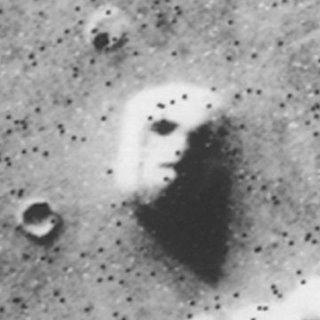
This is the famous 'Face on Mars', photggraphed by the Viking
space probe in 1976. The face appears to be manufactured, and
not natural.
Star Wars & Satellites
Aliens on the Moon
Aliens and Astronauts
Astronaut Statements
The Face on Mars
Mars has a face! No doubt you've seen pictures of it on
the covers of tabloids at your local supermarket. Yet there is much more to the
story than the mere resemblance of some blurry photos to a human face.
The Story
Photographs taken by NASA's 1976 Viking space probe show
what appears to be a humanoid face in the Cydonia region of the planet Mars. In
addition there appear to be other manufactured items, or artifacts. These other
artifacts appear to be large pyramids and other structures. They were
discovered by NASA scientists who closely examined thousands of photographs
using modern computer technology not available in 1976 when the photos were
taken.
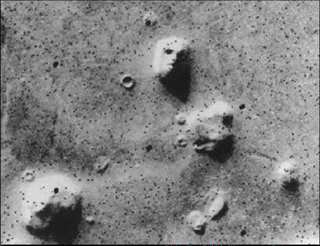
The Face on Mars and surrounding structures
What They Found
The "face" and other structures have
mathematical and geometrical correlations that match those of the Sphinx and
pyramids found in Egypt.
Richard Hoagland
The key scientist investigating this phenomena is a
fellow by the name of Richard Hoagland. Although some conventional scientists
deride his conclusions, his work has been extraordinary. He has been supported
by many scientists and engineers at NASA and the Jet Propulsion Laboratory
(JPL) in Pasadena, CA. In fact, I was present during one of his presentations
when some scientists from JPL walked up and handed him high-resolution photos
of Mars, showing clearly that intelligent life forms had built structures
there. One of them said to Hoagland, "We were wondering when you were
going to see this." Referring to the fact that Hoagland had already
identified many other "built" structures on Mars and the moon.
Hoagland has spent over ten years investigating Martian and Lunar photos using
computer-enhancement technology.
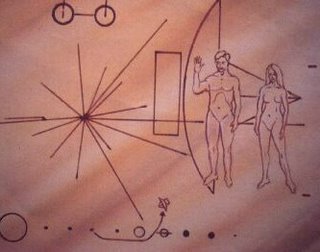
This is the Calling Card' plaque designed by Richard Hoagland
and put on the Pioneer and Voyager spacecraft. It describes
humans and the location of Earth in the event that alien beings
encounter the craft.
The United Nations
Hoagland has been invited on several occasions to present
his findings to the United Nations. His U.N. presentations are now available on
videotape. Hoagland is a legitimate and brilliant scientist who worked for NASA
for many years. He was one of the originators of the "Calling Card"
plaque that was first put on the Pioneer 10 space probe. The plaque describes humans,
our science, culture and where we are located to any beings who may come in contact with the probe.
Mr. Hoagland has been the science advisor to Walter
Cronkite at CBS and Kevin Sanders at CNN. He was also the editor of Star &
Sky Magazine. He is a past winner of the prestigious Angstrom Award, and has
appeared on "Nightline" and Art Bell's radio show. He is the author
of several books, including The Monuments of Mars. He knows what he's talking
about!
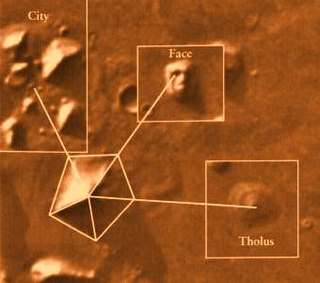
Photo of the Cydonia area of Mars containing the Face on Mars
and pyramid structures.
Another Scientist Speaks Up
At the 191st national meeting of the American
Astronomical Society (AAS), Dr. Tom Van Flandern presented his conclusions that
the face on Mars is not an optical illusion nor is it a naturally occurring
feature. Dr. Van Flandern holds a doctorate in astronomy from Yale University.
He was also chief of celestial mechanics at the U.S. Naval Observatory, a
highly respected astronomical facility. Van Flandern said there was less than a
1 percent chance the face was not made by intelligent hands.
Van Flandern based his conclusions on new analysis of the
existing data. He concluded his discussion by telling the five hundred
astronomers who were listening to his presentation: "I suggest that in
view of these test results, we prepare ourselves for a cultural shock certainly
unrivaled in recent times."
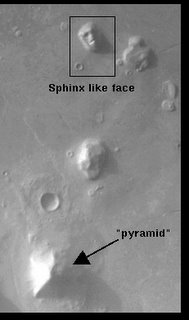
Huge pyramid near The Face on Mars
NASA Speaks
In response to an avalanche of questions from the public
and amateur astronomers NASA recently issued a lengthy and technical statement.
The statement began by saying that NASA would look further into the
"face" on Mars issue. They also stated they were not responding to
public pressure.
The Controversy
Another probe, the Mars Observer, was scheduled to reach
Mars in 1992. It had the capability to clearly photograph objects on Mars as
small as a coffee table. In an unprecedented move, as the Observer began to
orbit Mars NASA turned off the transmitter. They then claimed that they could
not turn it back on.
More Lost Probes
In case you were asleep, late in 1995 and again in mid
1996, NASA "lost" two more space probes. No explosion, no
explanation, just lost! The stories of these lost probes were carried in the
back pages of most American newspapers.
Several NASA insiders have come forward to say that the
agency "pulled the plug" on these probes to keep the public from
finding out about extraterrestrial beings.
Lost Power on the Mars Rover
Early in March 1998, NASA announced that the Mars Rover
lost complete power and was unable to send back any more pictures. Is this
possible? Of course. Mars is a long way off and malfunctions do happen. Is it
likely? No! Given NASA's history of deceit and lies to the American public, you
can assume they are lying once again.
Venus, Too!
NASA has also discovered on the planet Venus, a complex
consisting of a Sphinx and pyramids identical to the ones in Egypt in 1985.
They didn't tell you about that find either. NASA is bound by law to release
all their findings, so here's what they did. They broadcast the report over a
small station almost nobody could get, and of course, since nobody else was
broadcasting this information, those who heard it didn't believe it.
It's the old disinformation technique of telling people
the absolute truth, but doing it in such a way that no one will believe it.
Just so you know, NASA has mapped over 90 percent of the total surface of
Venus.
Russian Alien Encounters
NASA Alien Cover-Up
Modern Aircraft Technology
Home Page

|






